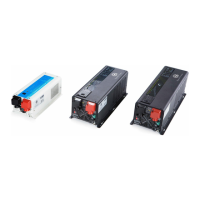Please follow the above minimum wire size requirement.
One cable is always best, but if there is a problem obtaining for example 100mm²cable, use 2*50mm²or
3*35mm² instead, as long as the square area adds up. Performance of any product can be improved by
thicker cable and shorter runs, so if in doubt round up and keep the length as short as possible.
Battery cables must have crimped (or preferably, soldered and crimped) copper compression lugs unless
aluminum mechanical lugs are used. Soldered connections alone are not acceptable. High quality, UL-listed
battery cables are available .These cables are color-coded with pressure crimped, sealed ring terminals.
Battery terminal must be clean to reduce the resistance between the DC terminal and cable connection. A
buildup of dirt or oxidation may eventually lead to the cable terminal overheating during periods of high
current draw. Use a stiff wire brush and remove all dirt and corrosion from the battery terminals and cables.
Reducing RF interference
To reduce the effect of radiated interference, twist the DC cables. To further reduce RF interference, shield
the cables with sheathing /copper foil / braiding.
Taping battery cables together to reduce inductance
Do not keep the battery cables far apart. In case it is not convenient to twist the cables, keep them taped
together to reduce their inductance. Reduced inductance of the battery cables helps to reduce induced
voltages. This reduces ripple in the battery cables and improves performance and efficiency.

